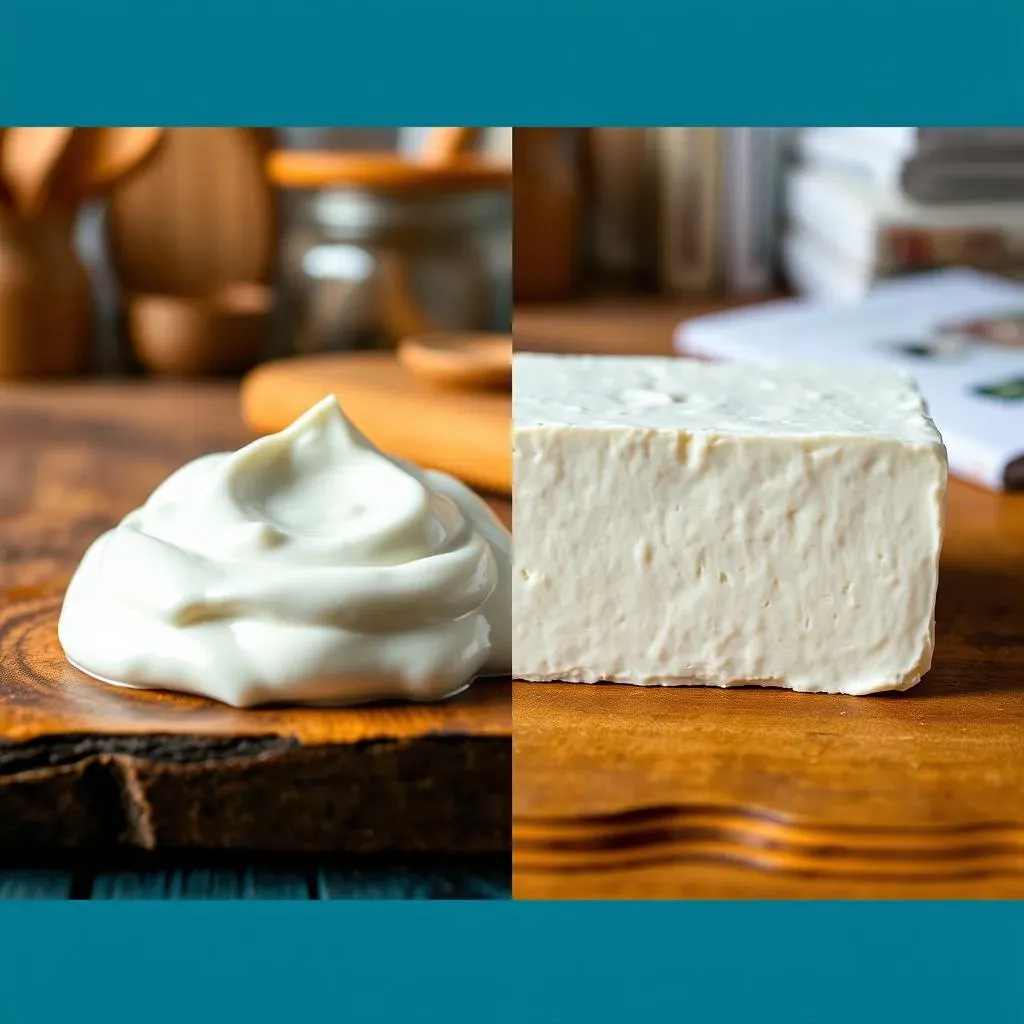Table of Contents
Ever stared blankly at a recipe, realizing you're out of sour cream? The panic sets in – can you even substitute? Well, wonder no more! This article tackles the burning question: can cream cheese substitute for sour cream? We'll explore the nuances of this swap, examining whether it's a viable option in your baking projects and savory creations. We'll delve into the differences in texture and taste between these two creamy ingredients, helping you decide if cream cheese is the right choice for your culinary adventure. Prepare to discover when a cream cheese swap works like a charm, and when it might lead to a recipe disaster. Get ready to confidently navigate the world of ingredient substitutions, knowing exactly when cream cheese can step in for sour cream and when it's best to stick with the original. Let's find out if you can successfully replace sour cream with cream cheese in your next recipe!
Can Cream Cheese Replace Sour Cream in Baking?

Can Cream Cheese Replace Sour Cream in Baking?
So, you're wondering if cream cheese can fill in for sour cream in your baking? It's a common question, and the answer is...it depends! Cream cheese is much denser and richer than sour cream, and it lacks that signature tang. In cakes and muffins where sour cream provides moisture and a slight acidic lift, using cream cheese might result in a denser, less fluffy texture. Think of it like this: sour cream is the light and airy cloud, while cream cheese is the solid, comforting earth. They're both delicious, but play very different roles in baked goods. For recipes that call for a small amount of sour cream (like a glaze or a topping), cream cheese might work, particularly if you thin it with a little milk or buttermilk. But for recipes that heavily rely on sour cream for texture and flavor, like sour cream coffee cake, it's best to stick to the original ingredient, or explore other substitutes, like buttermilk. If you're feeling adventurous, you could even try a blend of cream cheese thinned with milk and a touch of lemon juice to mimic sour cream's tang, but be prepared for some experimentation!
Ingredient | Baking Effect | Cream Cheese Substitute? |
|---|---|---|
Sour Cream | Adds moisture, tang, and helps create a light texture | No (unless in small quantities) |
Cream Cheese | Adds richness and density | Sometimes, but needs thinning and may alter flavor |
Many bakers find that using plain yogurt as a sour cream substitute offers a closer match in both texture and taste. It's a great option for cakes, muffins, and other baked goods where you need that tangy lift without the added density of cream cheese. Consider checking out this guide on using cream cheese as a substitute for more detailed information. Remember, baking is a science, and sometimes substitutions can throw off the delicate balance of a recipe. Always proceed with caution, and be prepared to adjust based on the results!
- Always test a small batch first before committing to a large recipe.
- Consider the role sour cream plays in the recipe.
- If in doubt, stick to the original recipe!
Using Cream Cheese as a Sour Cream Substitute in Savory Dishes

Using Cream Cheese as a Sour Cream Substitute in Savory Dishes
Cream Cheese in Dips and Spreads
Now, let's shift our focus from baking to savory dishes. Here, cream cheese can actually be a surprisingly versatile sour cream substitute, especially in dips and spreads. Its richness and creaminess lend themselves well to creating flavorful bases. Think creamy spinach and artichoke dip, or a luxurious herbed cream cheese spread for crackers. The key here is to consider the overall flavor profile. Since cream cheese is milder than sour cream, you might need to amp up the seasonings to achieve the desired taste. A dash of lemon juice or vinegar can also help mimic sour cream's tang. For a truly authentic sour cream taste, a blend of cream cheese and a bit of plain yogurt can often hit the mark. Remember, you can adjust the consistency by adding a splash of milk or water to achieve your desired creaminess.
Don't be afraid to experiment! The beauty of cooking is in the exploration of flavors and textures. Start with a small batch of your dip or spread to test the cream cheese substitution before diving into a large quantity. This allows you to fine-tune the seasoning and consistency to perfection. Sometimes, the best results come from unexpected combinations. For instance, a touch of finely chopped chives or dill can elevate a simple cream cheese dip into something truly special.
Dip/Spread | Cream Cheese Works Well? | Tips for Success |
|---|---|---|
Spinach Artichoke Dip | Yes | Add a squeeze of lemon juice for tang |
French Onion Dip | Yes, with adjustments | Use a mix of cream cheese and plain yogurt |
Ranch Dip | Potentially, with herbs | Thin with milk; adjust herbs for flavor |
Cream Cheese in Sauces and Dressings
Moving beyond dips, cream cheese can also find a place in some sauces and dressings, though with more caveats. In creamy sauces for pasta, for example, cream cheese can add a luxurious richness. However, because of its higher fat content, it's crucial to be mindful of the heat. High temperatures can cause cream cheese to separate or become grainy. Therefore, it's best to incorporate cream cheese towards the end of the cooking process, or use it in cold sauces and dressings. Remember that cream cheese lacks the acidity of sour cream, so you might need to add a bit of lemon juice or white wine vinegar to balance the flavors.
When substituting cream cheese for sour cream in dressings, keep in mind the consistency. Cream cheese is thicker, so you may need to add more liquid to thin it out. This could be something as simple as water, or you could experiment with adding a bit of buttermilk for a tangier flavor. A creamy dill dressing, for example, could be greatly enhanced by the creaminess of cream cheese, provided you thin it appropriately and add some fresh dill. Always start with a small amount and gradually increase until you achieve the desired consistency and flavor profile. For more ideas on dairy substitutions, check out our guide on cottage cheese substitutes.
- Add cream cheese to sauces at the end of cooking.
- Thin cream cheese with milk or buttermilk in dressings.
- Adjust seasoning to compensate for the milder flavor of cream cheese.
Cream Cheese vs. Sour Cream: Texture, Taste, and Best Uses

Cream Cheese vs. Sour Cream: Texture, Taste, and Best Uses
Understanding the Differences
Let's get down to brass tacks: cream cheese and sour cream aren't interchangeable twins; they're more like distant cousins with a few family resemblances. Sour cream boasts a tangy, slightly acidic flavor and a thinner, pourable consistency. Think of it as the versatile sidekick in your kitchen, perfect for dressings, dips, and adding a zing to baked goods. It’s that light and airy cloud we talked about earlier. Cream cheese, on the other hand, is a rich, dense, and relatively mild-flavored spread. Its texture is thick and creamy, ideal for frosting, dips, and spreading on bagels. It’s that comforting earth. The key difference lies in their fat content and the way they're made. Sour cream is cultured cream, meaning bacteria are added to ferment the cream, giving it its tangy flavor. Cream cheese, however, is made by adding cream to milk, then adding acid to cause the mixture to coagulate, creating its thick consistency. For a deeper dive into buttermilk substitutes, check out our guide on buttermilk substitutes.
This fundamental difference in production methods leads to vastly different culinary applications. Sour cream excels in dishes where a bright, acidic note is desired, while cream cheese shines in applications where richness and creaminess take center stage. Choosing the right one depends entirely on the desired outcome of your recipe. Sometimes, a little creativity can allow you to blend the best of both worlds, but generally understanding these differences will help you select the right ingredient for your dishes. For example, if you're aiming for a tangy dip, sour cream is your go-to. If you're making a rich, creamy frosting, cream cheese is the way to go. To learn more about alternative cream cheese substitutes, explore our comprehensive guide on cream cheese substitutes.
Characteristic | Sour Cream | Cream Cheese |
|---|---|---|
Flavor | Tangy, slightly acidic | Mild, creamy |
Texture | Thin, pourable | Thick, spreadable |
Fat Content | Higher than milk, lower than cream cheese | Very high |
Best Uses | Dressings, dips, baked goods | Frosting, dips, spreads |
Choosing the Right Ingredient
Ultimately, the "best" choice between sour cream and cream cheese hinges entirely on the specific recipe and desired outcome. In baking, sour cream often plays a crucial role in creating a tender crumb and a subtle tang. Substituting cream cheese will likely result in a denser, less airy product. However, in savory dishes, cream cheese's richness and creaminess can be a significant asset. It can create luxuriously creamy sauces and dips, but remember that its milder flavor might require additional seasoning to achieve the desired taste. Using a combination of cream cheese and sour cream, or adding a touch of lemon juice or vinegar, can help bridge the gap between the two, allowing you to customize the flavor and texture to your liking.
When substituting one for the other, it's always a good idea to start with a small batch to test the waters. This allows you to fine-tune the seasoning and consistency without committing to a large quantity. Remember, cooking is an art form, and experimentation is key to unlocking your culinary potential. Don't be afraid to experiment with different proportions and flavor combinations to find what works best for you. For a healthier alternative, consider exploring cottage cheese substitutes for sour cream in your recipes.
- Consider the recipe's desired flavor profile.
- Think about the texture you want to achieve.
- Experiment with small batches to fine-tune the result.